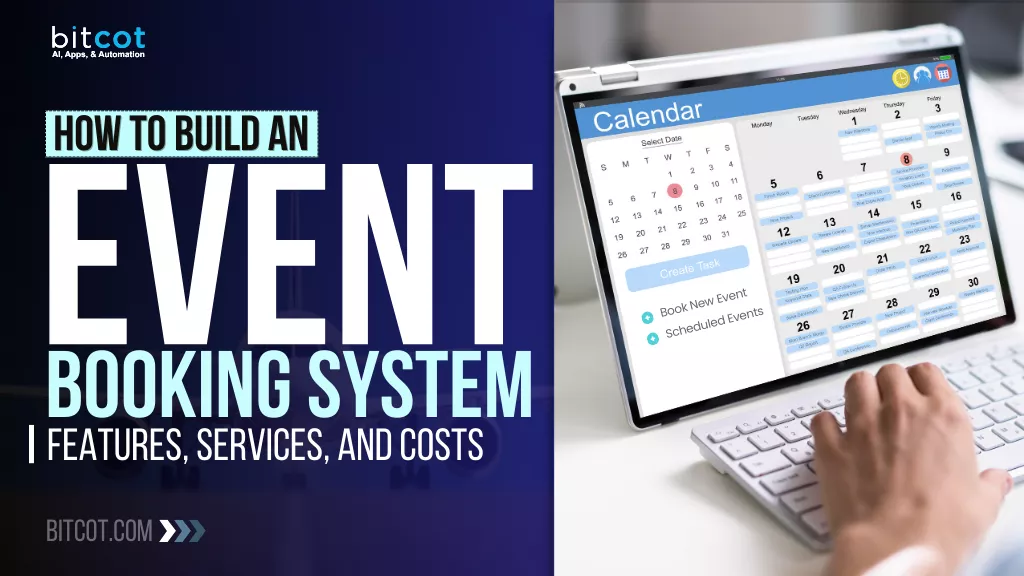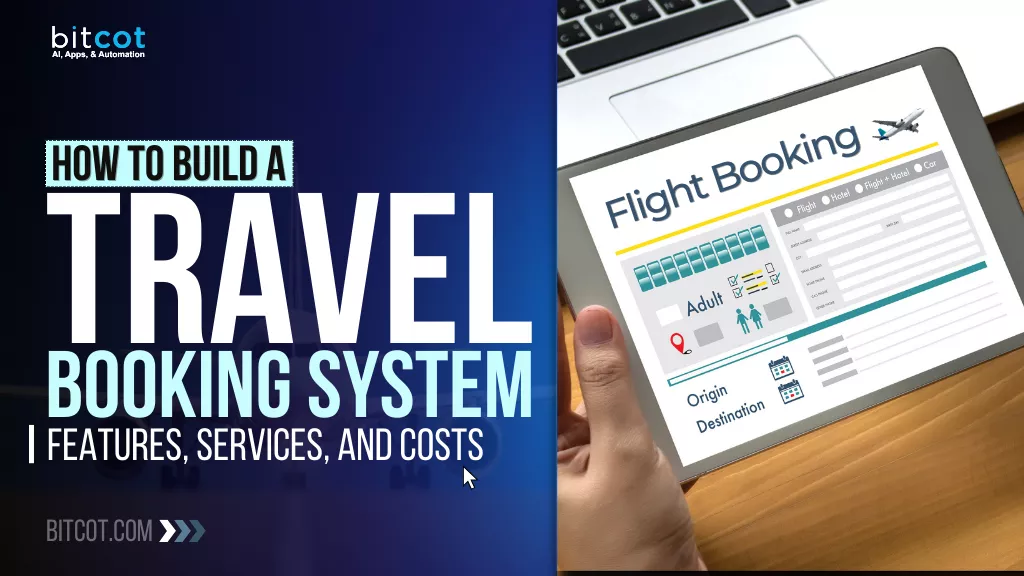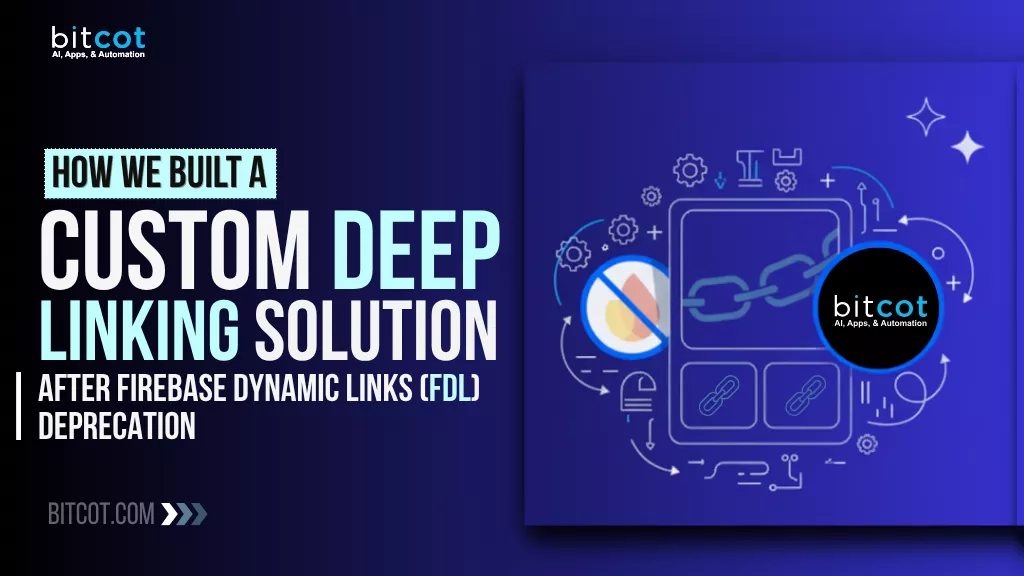
Your users click links from every source, such as email campaigns, social media, referral programs, and in-app messages, all expecting to land exactly where they need to be.
But if your deep links break or redirect incorrectly, every click becomes a dead end. Your marketing data loses accuracy, your app loses installs, and your users lose patience.
Sound familiar?
Today’s mobile experiences demand seamless, platform-aware redirection. When your links fail, your engagement drops, and your growth stalls.
In this post, we’ll walk through how we built a custom deep linking solution to replace Firebase Dynamic Links, a scalable, secure, and analytics-rich system that puts you in full control. You’ll see how we approached platform detection, deferred deep linking, and real-time analytics, along with the cost savings that came from removing third-party dependencies.
Ask yourself:
- How much tracking data do you lose because of broken links?
- How often do users drop off before even reaching your app?
- You already know the frustration, but what if you could own every part of your deep link flow?
Whether you’re a developer, product manager, or growth marketer, this challenge is real. Every failed link is a lost conversion, a missed install, a wasted campaign.
Our custom deep linking implementation changes that. It’s fast, self-hosted, and works across iOS, Android, and desktop, with full analytics and deferred deep link support.
Bitcot helps you make that shift. We build reliable, future-proof deep link systems that keep your users connected and your data accurate.
The future of linking is ownership, not dependency.
Are you ready to take control?
Understanding the Need for Custom Deep Linking
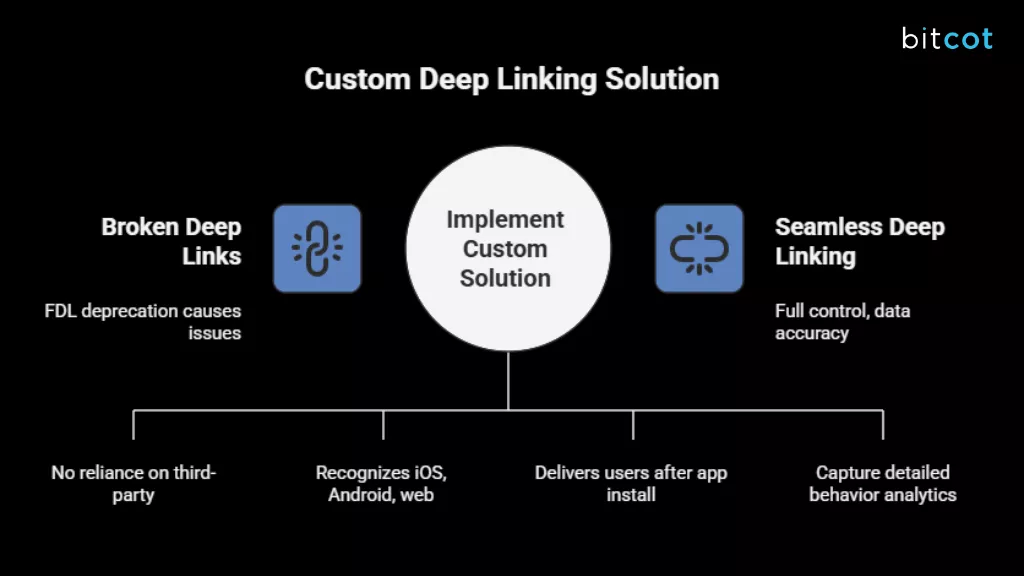
When Firebase Dynamic Links (FDL) was deprecated in August 2025, many apps suddenly faced a major challenge: how to maintain seamless deep linking without relying on a service that no longer existed.
Deep links are more than just URLs; they are the invisible bridges connecting your marketing campaigns, websites, and apps. They ensure users land exactly where you want them to, whether that’s a product page, onboarding flow, or personalized offer.
Without a reliable deep linking system:
- Marketing campaigns lose attribution and tracking accuracy
- Users face broken journeys and app reinstall friction
- Teams spend time fixing redirects instead of improving the experience
A custom deep linking solution solves all of this by giving you full control, from link generation to analytics.
It allows for:
- Self-hosted control: No reliance on third-party services or future deprecations
- Platform awareness: Automatically recognizes iOS, Android, or web users
- Deferred deep linking: Delivers users to the right place even after app install
- Rich metadata tracking: Capture detailed behavior analytics for every click
By owning the full system, you protect your user experience, maintain data accuracy, and reduce long-term costs.
With that foundation in place, let’s walk through how Bitcot engineered a robust, production-ready custom deep link solution, replacing FDL entirely while adding powerful new capabilities.
An Overview of Our Custom Deep Linking Solution
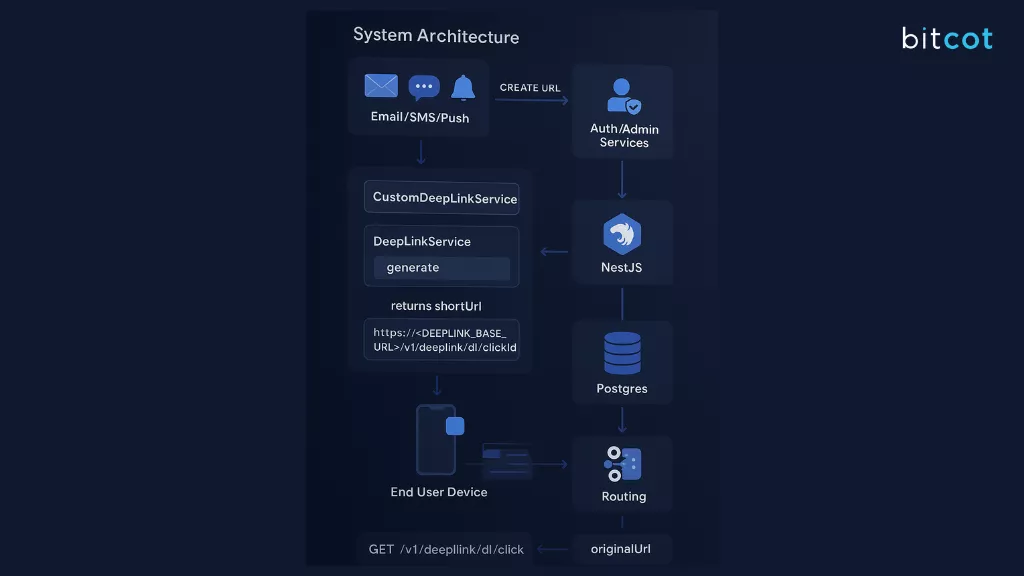
When Firebase Dynamic Links (FDL) was officially deprecated in August 2025, it left many businesses scrambling to find reliable alternatives.
Rather than moving to another dependency, we chose to take control and build a fully custom deep linking solution, one that could not only replace Firebase but also deliver greater flexibility, performance, and insight.
Our engineering team designed, developed, and deployed a self-hosted deep link system that ensures every user lands exactly where they should, every time. This solution was built to handle complex use cases, support multiple platforms, and provide a complete analytics view of user behavior, all while staying fully under our control.
Here’s what makes it powerful:
- Self-hosted deep link generation with UUID-based tracking: Every deep link is created and managed within our own infrastructure, using unique UUID identifiers for precision tracking. This eliminates dependency on third-party services and gives us full ownership of the link lifecycle, from creation to click event.
- Rich metadata for analytics and user behavior tracking: Each link carries custom metadata, such as campaign source, user ID, or product reference, which enables detailed analysis of how users engage with links across different channels. This data feeds directly into analytics dashboards for actionable insights.
- Platform-aware redirection: The system intelligently detects the user’s platform, whether iOS, Android, or desktop, and redirects them using the appropriate standard: Universal Links for iOS, App Links for Android, or a browser-based fallback for desktop users. The result is a seamless cross-platform experience without extra configuration.
- Deferred deep linking for first-time installs: One of the biggest challenges in mobile marketing is ensuring users who install the app after clicking a link still land in the right place. Our system stores the original click context and delivers it to the app post-install, creating a frictionless onboarding experience.
- Comprehensive click analytics: Every click event is logged with device details, browser type, referrer, timestamp, and more. This allows for full-funnel visibility, from link creation to user action, without relying on third-party analytics platforms.
- Smart fallback and error handling: Even in edge cases, such as outdated app versions or unsupported environments, the system gracefully redirects users to a safe destination like the App Store, Play Store, or a relevant web page. No broken links, no lost users.
In short, this solution does more than just replace Firebase; it elevates deep linking into a self-sustaining, analytics-driven system that can scale with business needs. It’s fast, secure, and built to last.
Cost Savings from Building a Custom Deep Linking Solution
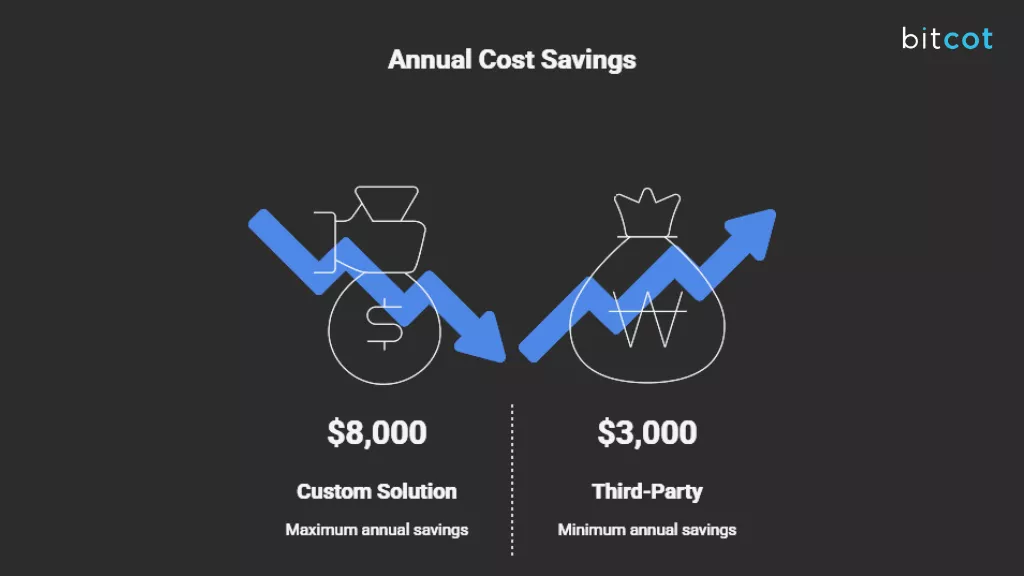
Beyond the technical success, one of the most tangible outcomes of building our own deep linking system was significant cost reduction.
By replacing Firebase Dynamic Links (FDL) with a self-hosted alternative, we not only avoided the disruption caused by its deprecation in August 2025 but also eliminated multiple recurring expenses tied to third-party services.
Immediate Savings
- Avoided service shutdown impact: When Firebase Dynamic Links was discontinued, many apps faced the risk of broken links and lost attribution data. Our proactive implementation ensured a smooth transition with zero downtime and no service interruptions.
- No third-party dependencies: By moving to a fully self-hosted system, we eliminated subscription costs for external link shortening or analytics tools. The solution now runs entirely on our existing infrastructure; no vendor lock-ins, no surprise fees.
- Reduced infrastructure costs: The new deep link service was designed to integrate seamlessly with our current stack, requiring no additional servers or licenses. We leveraged our existing databases, APIs, and hosting environments, keeping costs minimal and maintenance simple.
Estimated Annual Savings
Switching from Firebase and other third-party solutions has resulted in clear, measurable financial benefits:
- Replacement for Firebase Dynamic Links alternatives: Equivalent commercial services would have cost $2,000-$5,000 per year for the same level of functionality.
- Third-party analytics platforms: By embedding our own click tracking and reporting, we saved another $1,000-$3,000 per year in analytics expenses.
- Reduced development and integration time: The project’s efficient design and modular architecture saved 40-60 hours of engineering effort typically needed for integration and maintenance.
In total, our custom deep linking system saves between $3,000 and $8,000 annually, while providing deeper insights, better performance, and full data ownership.
These savings are not just financial; they represent freedom from dependency, improved agility, and the ability to scale without external constraints.
Development Timeline for Our Custom Deep Linking Solution
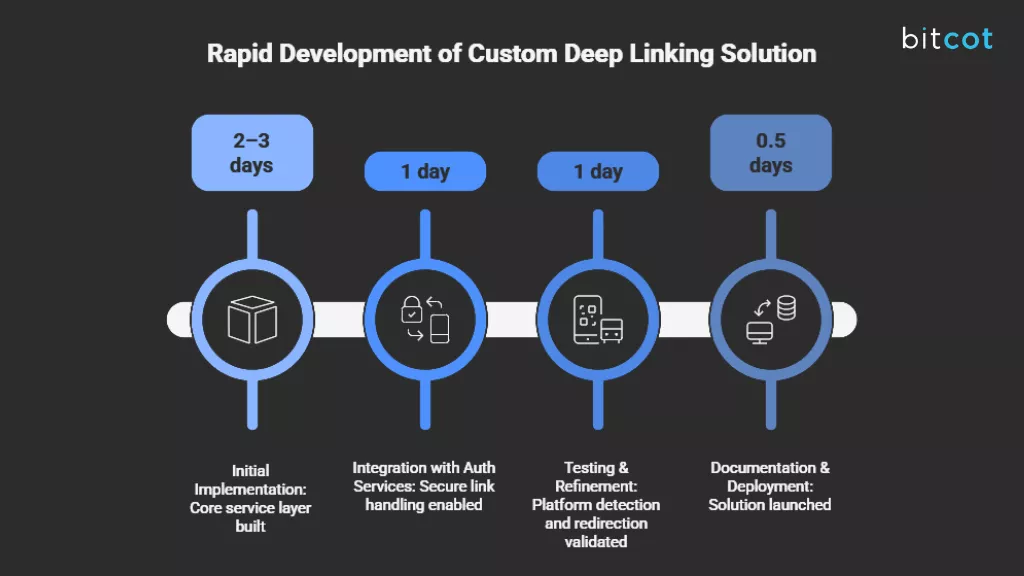
Speed was critical for this project.
With Firebase Dynamic Links deprecating in August 2025, the team needed to deliver a complete replacement quickly to ensure seamless continuity for users and campaigns.
Despite the complexity of the task, we completed the full implementation, from design to deployment, in less than five days.
- Initial Implementation: ~2–3 days – We began by building the core service layer, generating links, managing UUID-based tracking, and replicating Firebase’s core functionality to ensure backward compatibility.
- Integration with Auth Services: ~1 day – The next step involved integrating the system with existing authentication workflows, enabling secure, context-aware link handling.
- Testing & Refinement: ~1 day – We conducted comprehensive testing across iOS, Android, and desktop environments to validate platform detection, redirection accuracy, and deferred deep linking reliability.
- Documentation & Deployment: ~0.5 days – The final phase focused on preparing developer documentation and deploying the solution to production.
From start to finish, the deep linking system was fully operational in about 4.5 days, a reflection of clear requirements, clean architecture, and an efficient development process.
Interesting Challenges Solved During the Firebase Dynamic Links Migration
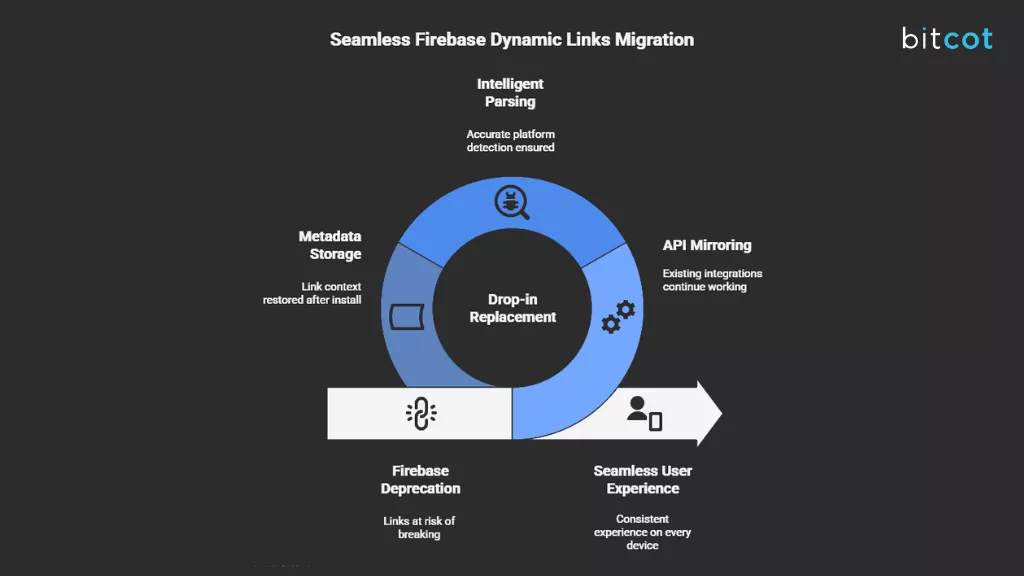
Every migration project comes with unique hurdles, and replacing Firebase Dynamic Links (FDL) was no exception. Since Google announced FDL’s deprecation in August 2025, businesses needed reliable alternatives that wouldn’t disrupt user journeys or marketing attribution.
Our goal was not only to replace Firebase but to improve upon it.
Here’s how we solved the biggest technical challenges during the transition.
1. Firebase Migration Challenge
Problem: Firebase Dynamic Links was discontinued with no direct migration path, putting apps at risk of broken deep links and data loss.
Solution: We built a drop-in replacement that perfectly mirrored Firebase’s API interface, allowing existing integrations to continue working without any code rewrites.
Result: Zero downtime migration with enhanced flexibility, better analytics, and a fully self-hosted architecture.
2. Platform Detection and Redirection
Problem: Managing deep links across multiple platforms, including iOS, Android, and desktop, required complex, platform-specific logic.
Solution: We developed intelligent User-Agent parsing combined with Universal Links and App Links support, ensuring accurate platform detection and smooth redirection.
Result: A consistent, seamless user experience on every device, with no broken paths or lost sessions.
3. Deferred Deep Linking
Problem: Deep links often lose context when clicked before the app is installed, leading to poor onboarding experiences.
Solution: We implemented metadata-based click storage that captures link context and restores it once the app launches after installation.
Result: A true deferred deep linking experience; users land exactly where they intended to, even after installing the app for the first time.
High-Quality Implementation of Our Custom Deep Linking Solution
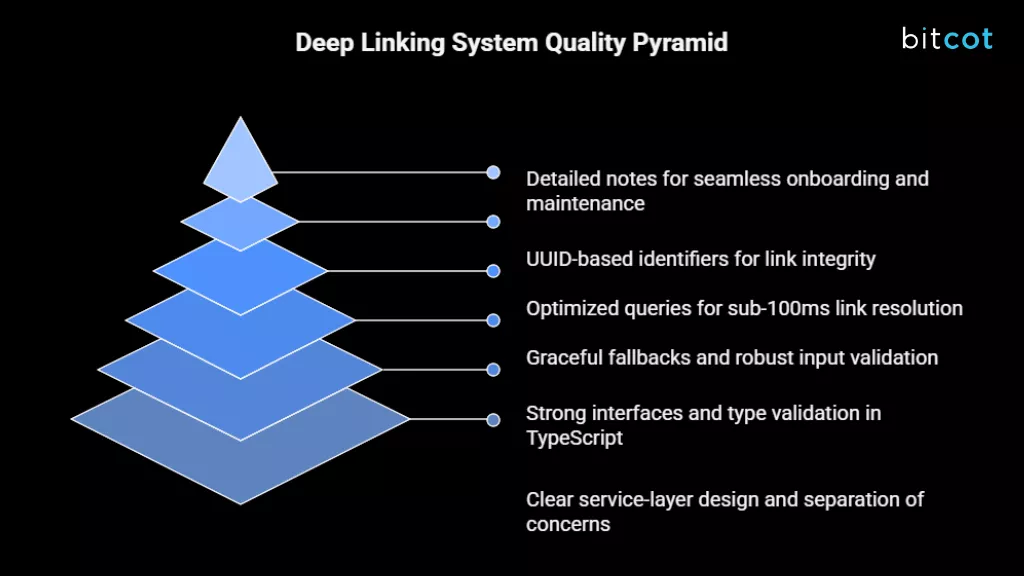
Delivering a reliable Firebase Dynamic Links replacement required not just speed, but precision and attention to detail.
Our goal was to create a deep linking system that would be fast, secure, and maintainable, built to scale with business growth.
Every layer of the implementation was designed with clean architecture, type safety, and performance optimization at its core.
High-Quality Implementation Highlights
- Clean Architecture: Built with a clear service-layer design and separation of concerns, ensuring each module handles a single, well-defined responsibility.
- Type Safety: Fully implemented in TypeScript, with strong interfaces and type validation throughout, reducing runtime errors and improving code reliability.
- Error Handling: Designed with graceful fallbacks and robust input validation, ensuring the system remains stable even under unexpected conditions or malformed requests.
- Performance: Optimized database queries, proper indexing, and lightweight service calls enable sub-100ms link resolution on average.
- Security: UUID-based link identifiers provide strong validation and prevent predictable URL patterns, enhancing overall link integrity.
- Documentation: Every component includes detailed developer notes and inline comments, making onboarding and maintenance seamless for future teams.
Code Quality Metrics
- Maintainability: High – clean, modular codebase designed for long-term sustainability.
- Scalability: High – database-driven architecture that supports growing link volumes effortlessly.
- Testability: Good – service-oriented design simplifies unit testing and integration validation.
- Performance: Excellent – consistent link resolution times under 100ms across environments.
Partner with Bitcot to Build Your Custom Deep Linking Solution
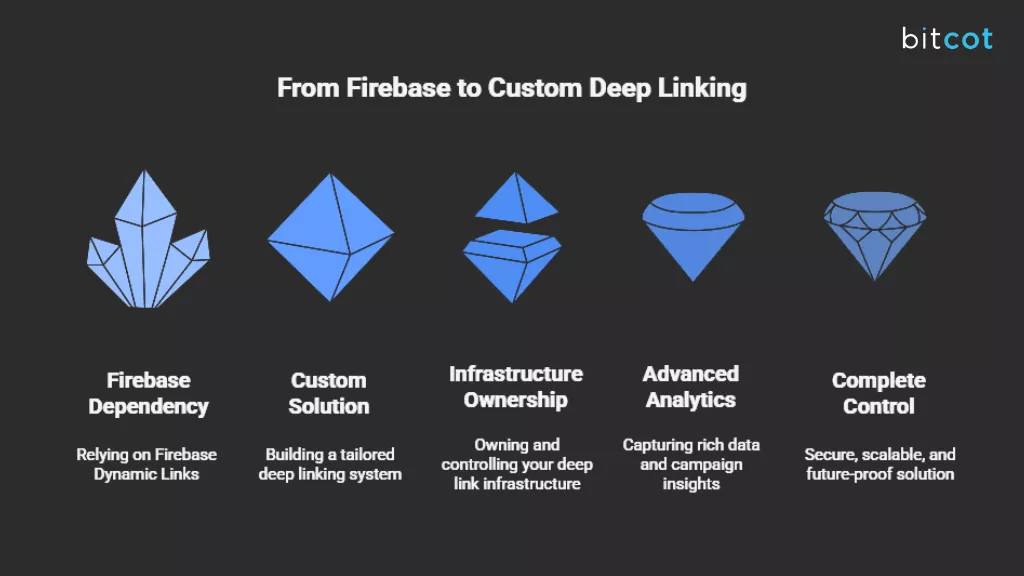
The deprecation of Firebase Dynamic Links in August 2025 marked a major shift for mobile developers and businesses relying on seamless user journeys.
But it also opened the door for something better: custom deep linking solutions that give you complete control, flexibility, and long-term reliability.
At Bitcot, we specialize in building custom, self-hosted deep linking systems tailored to your app’s unique needs. Whether you’re migrating from Firebase, improving user attribution, or enabling advanced analytics, our team helps you design a solution that’s secure, scalable, and future-proof.
With our proven framework, you can:
- Own your entire deep link infrastructure; no third-party dependencies
- Enable platform-aware redirection across iOS, Android, and web
- Capture rich analytics and campaign insights for every click
- Support deferred deep linking for a seamless first-time user experience
- Reduce operational costs while increasing reliability and data accuracy
Our deep linking implementations are built to grow with your product, integrating cleanly with your existing authentication, analytics, and backend systems.
Bitcot helps you take control of your app experience from the first click to conversion.
Let’s build the deep linking solution your users and your business deserve.
Final Thoughts
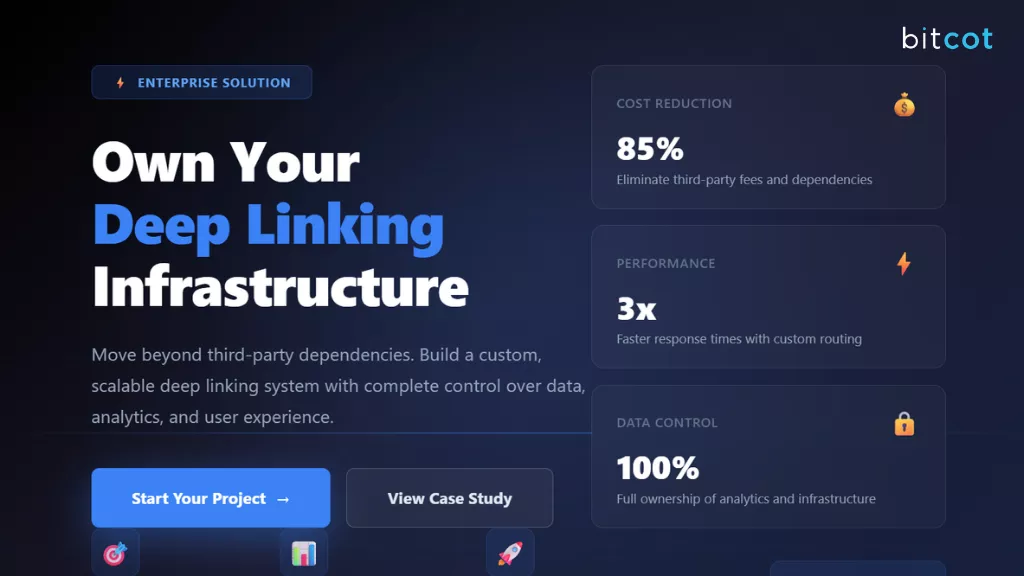
The custom deep linking implementation represents more than just a successful migration from Firebase Dynamic Links; it’s a long-term investment in ownership, performance, and scalability.
This solution directly addresses a critical business need: maintaining seamless user journeys while ensuring full control over data, analytics, and infrastructure. By removing third-party dependencies, we achieved not only significant cost savings but also greater flexibility and reliability.
The result is a production-ready, scalable deep linking system that delivers measurable value today and provides a strong foundation for future enhancements, from richer analytics integrations to advanced personalization and automation.
In a digital landscape where every click matters, owning your deep linking infrastructure means owning your user experience. And with Bitcot’s expertise, you can build a system that evolves with your business, not one that limits it.
The future of deep linking is independent, intelligent, and fully under your control.
At Bitcot, we don’t just build software; we build solutions that scale. Whether you need a custom deep linking system, an AI-powered automation platform, or a complete mobile and web application, our team delivers end-to-end custom software development services tailored to your business goals.
Let’s create technology that connects your users, enhances your workflows, and drives measurable growth.
Get in touch to explore how our custom software development services can power your next digital success.



